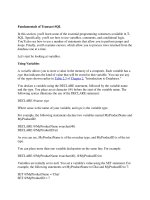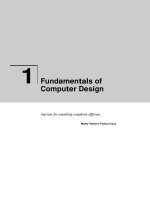Fundamentals of Ethernet Technology
Bạn đang xem bản rút gọn của tài liệu. Xem và tải ngay bản đầy đủ của tài liệu tại đây (550.88 KB, 8 trang )
WHITE PAPER
Fundamentals of
Ethernet Technology
Fundamentals of
Ethernet Technology
This white paper provides a brief tutorial on Ethernet – a family of standards that
defines several well-established 10 Mbps networking technologies and three
newer, high-speed offerings, Fast Ethernet, Gigabit Ethernet, and 10 Gigabit
Ethernet. It is intended for carrier network professionals, experts in the circuit-
switched technologies employed in public switched telephone networks (PSTN)
but often new to Ethernet and data networking.
Why Study Ethernet?
Ethernet is becoming an important carrier network technology. For many years,
it was relegated to office LANs (local area network), connecting PCs, servers, and
printers. Recent high-speed implementations, however, make Ethernet a viable
candidate to provide new carrier-based services such as:
• Voice over IP (VoIP), a technology that enables voice calls over data networks.
This may one day eliminate the need for separate voice and data facilities.
• Metropolitan area networks (MANs), high-bandwidth pipes that can link
company data centers over a 15 to 20 mile area
• Ethernet in the First Mile (EFM), an emerging standard that may compete with
DSL and cable modems to bring voice, video, and data to homes
The PSTN and Ethernet
The PSTN and Ethernet were designed for very different purposes. The result
is different technologies, at least in two key areas: switching techniques and
network access methods.
Circuit-Switching: A Voice-Friendly Technology
Have you ever heard a television news anchor question a
distant reporter over a satellite link? You probably have,
and it’s quite likely that the moments of dead air between
the question and the response made you uncomfortable.
That’s what latency does to conversation. Designers of the
public telephone network understood this, so they created
circuit-switched networks to minimize it. In these networks,
an end-to-end circuit is established (Figure 1) before a
conversation begins, and circuit resources aren’t relinquished
until someone hangs up. The bandwidth allocation, though
modest, is guaranteed.
Figure 1. Circuit-Switched Network
Page 3
New Requirements
Circuit switching worked quite well when most network traffic was voice. As data became a bigger part of the traffic
mix, however, it became less attractive. For data, latency isn’t as important as sufficient bandwidth to support brief,
but often large transmission bursts. As you can see from the following table, voice and data traffic have very different
transport requirements.
Traffic Bandwidth Required Burst Support Latency
Voice Small amount of reserved bandwidth Not Required Must be low
Data Variable bandwidth needs Extremely Important Not Important
Fundamentals of Ethernet Technology
DCE
Packet
A
Packet
B
DCE
Figure 2. Packet-Switched Network
Packet-Switching: A Data-Friendly Technology
Differing requirements drove the development of a
new data-friendly type of network, one that employed
a technology called packet-switching. Packet-switched
networks, including Ethernet, don’t bother to set up
an end-to-end circuit. Instead, the sender simply gains
access to the network and begins transmitting. Data is
divided into small independent units called packets that
are multiplexed onto high-capacity network connections.
Each packet is routed separately—based on addressing
information contained in the packet—and each packet
may take a different route to the destination (Figure 2).
A drawback to this “connectionless” service is that the
network cannot guarantee delivery. Network resources
are not reserved prior to transmission. Packets may be
lost because intermediate resources are busy or not
functioning. They may arrive out of order. The destination
system may not be on or connected to the network.
Though this method may sound awfully risky, service is
usually quite reliable. Mechanisms within the network
enable routing around busy or failed resources, and end
system software is designed to reassemble out-of-order
packets and to detect and recover from errors.
Switching Methods: An Analogy
Trains and cars provide a good analogy for how circuit switching and packet switching differ. Trains use the circuit-
switched model. The track is reserved for the entire length of the trip, each car on the train takes the same route to the
destination, and the engineer can’t decide to take a different route. Cars use the packet-switched model. Each driver
makes independent decisions about the best way to get to the destination. If a traffic jam is encountered, the driver
will switch lanes or even get off the freeway and take an alternate route. Cars going to the same destination may use
different routes to get there.
Fundamentals of Ethernet Technology
Page 4
Access Method Figure Description
Centralized
Access
Master Slave A
Your turn A
Slave B
Centralized access is characterized by a single
point of control. The controlling station
determines when each station can use the
medium to transmit data. Typically, this
involves some type of polling. A slave station
can transmit only when it is polled by the
master station.
Deterministic
Access
Token
Ring
Token
Deterministic access means stations transmit
in turn. In a token ring network, for example,
an electronic token is passed around the
ring, from station to station. Transmission is
permitted only when a station controls the
token.
Contention
Transmit Transmit
Collision
On a network that uses contention, any
station can transmit at any time, which is
a problem if two or more stations transmit
simultaneously. See the following section
for information on how CSMA/CD, the
contention method used on Ethernet
networks, manages channel access.
Shared Access on the PSTN: TDM
Though resources are guaranteed on the PSTN, exclusive
use of the cable from the originating phone to the
destination phone is prohibitively expensive. To provide
guaranteed bandwidth and still provide a means for
sharing the communication channel, time division
multiplexing (TDM) – the T-carrier system – has been
employed on the PSTN since the 1960s. With this system,
each phone conversation is given exclusive use of the
channel for a very short period. Samples of the speaker’s
voice are taken repeatedly, encoded into digital format,
and transmitted to the receiving telephone during
the time slice allocated for the call. The guaranteed
bandwidth (64 Kbps) is sufficient to give the telephone
users the illusion of exclusive use of resources.
Shared Access on an Ethernet LAN:
The Alternatives
Like the PSTN, Ethernet – originally designed for a shared
bus network – required some method for allocating use
of the communication channel among multiple network
stations. As discussed earlier, guaranteed bandwidth
isn’t important for data transport, so TDM wasn’t a
serious alternative. The data networking world provided
other alternatives, however, which can be divided
into three types or classes: centralized, deterministic,
and contention. The method the Ethernet designers
developed, CSMA/CD, follows the contention model.
Fundamentals of Ethernet Technology
Page 5
CSMA/CD
With CSMA/CD (Carrier Sense, Multiple Access/Collision Detection), a station that wants to transmit first “listens” to the
medium to determine whether another station is currently transmitting. If the medium is quiet, the station transmits. If
two stations accidentally transmit simultaneously, they each detect the collision and stop transmitting. Each then waits for
a random period before attempting to transmit again.
Ethernet Development
When first developed by Xerox Corporation, Ethernet was a proprietary LAN technology that operated on a shared
coaxial bus and was used exclusively for data. At its heart was the CSMA/CD access method. Since then, extraordinary
innovation has made a hash of these categories. The technology, for one thing, is no longer proprietary. The IEEE
standardized it in 1983 as IEEE 802.3, a document that has been updated more than a dozen times to include
improvements to the technology. These include:
• New types of cables: While coaxial is still an option, newer installations use less expensive unshielded twisted pair or
higher capacity fiber.
• New topologies: Cabling for the newer Ethernet standards uses a star, a bus-star hybrid called a tree, and even a ring.
• Increased bandwidth: The standards now define speeds between 1 Mbps and 1 Gbps (soon 10 Gbps).
• Support for full-duplex operation: The original standard supported half-duplex only. (On full-duplex networks, CSMA/
CD is not required.)
• Expansion of the distances supported: Ethernet is no longer restricted to the LAN. It is now deployed in MAN
networks, and will soon provide the underlying service in WAN (wide area network) environments as well.
• Support for new applications: Gigabit and 10 Gigabit Ethernet are able to provide transport for voice and video as well
as data.
Ethernet Advantages
Over the years, Ethernet has gained wide acceptance because it offers clear advantages over competing technologies.
Ethernet is:
• Easy to understand, implement, manage, and maintain
• Standards-based, largely guaranteeing communication with other compliant devices
• Relatively inexpensive. Many Ethernet devices have become commodities, and many systems are connected with
inexpensive twisted-pair cables.
• Highly flexible. Ethernet supports multiple topologies and types of cabling. New high-speed offerings support not only
data, but voice and video as well.
• Highly reliable. It’s a well-tested technology.









